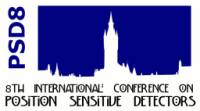Description
Applications in Particle Physics
Themis Bowcock
(University of Liverpool)
04/09/2008, 09:00
Applications in Particle Physics
Keynote talk
We summarize the state of position sensitive detectors for particle physics. Particular attention is given to the technologies for the next generation of detector replacements and upgrades for the LHC. The latest developments in radiation hard devices are reported together with recent results on novel devices. A brief review of possible applications of these new technologies to future...
Jovan Mitrevski
(Santa Cruz Inst. for Particle Phys. (SCIPP) - Univ. of Californi)
04/09/2008, 09:40
Applications in Particle Physics
Oral Contribution
The ATLAS SemiConductor Tracker (SCT) has been installed, and fully connected to electrical, optical and cooling services. Commissioning has been performed both with calibration data and cosmic ray events. The cosmics were used to align the detector, measure the hit efficiency and set the timing. The SCT is now ready to take data when the LHC turns on this autumn. At the same time, it is clear...
Alexander Dierlamm
(University of Karlsruhe)
04/09/2008, 10:00
Applications in Particle Physics
Oral Contribution
The LHC accelerator complex will undergo a program of consolidation and upgrade of various components, with goal of exceeding a peak luminosity of 1034 (original design figure) around the year 2013, to eventually reach values close to 1035. Such luminosity upgrade poses new challenges to the detector operation, both in terms of instantaneous and integrated rates. In CMS the system that have...
Phil Allport
(U. of Liverpool)
04/09/2008, 10:20
Applications in Particle Physics
Oral Contribution
Planar, segmented silicon sensors are used for the tracker and vertex detectors for high energy physics experiments at the Large Hadron Collider (LHC) because of their unsurpassed performance in terms of granularity, resolution and speed while offering relatively low mass. The planned luminosity upgrade of the Large Hadron Collider at CERN (Super-LHC, sLHC) will provide a challenging...
Dr
Panja-Riina Luukka
(Helsinki Institute of Physics HIP)
04/09/2008, 11:10
Applications in Particle Physics
Oral Contribution
Pad and strip detectors processed on high resistivity n-type magnetic Czochralski silicon were irradiated to several different fluences with protons. The pad detectors were characterized with Transient Current Technique (TCT) and the full-size strip detectors with a reference beam telescope and 225 GeV muon beam. The TCT measurements indicate a double junction structure and space charge sign...
Ulrich Parzefall
(Fakultaet fuer Physik)
04/09/2008, 11:30
Applications in Particle Physics
Oral Contribution
The luminosity upgrade of the LHC to the SLHC will mean a massive increase in radiation levels for the tracking detectors close to the interaction point. The development of ultra-radiation hard silicon detectors is required for the innermost tracking layers. One option for radiation-hard silicon sensors is the 3D technology, where columnar electrodes are etched deep into the silicon bulk. This...
Harris Kagan
(Ohio State University)
04/09/2008, 11:50
Applications in Particle Physics
Oral Contribution
With the commissioning of the LHC expected in 2008, and the LHC upgrades expected in 2012, ATLAS and CMS are planning for detector upgrades which require radiation hard technologies. Chemical Vapor Deposition (CVD) diamond has been used extensively in beam conditions monitors as the innermost detectors in the highest radiation areas of BaBar, Belle and CDF and is now planned for all LHC...
Dr
Gennaro Ruggiero
(CERN)
04/09/2008, 12:10
Applications in Particle Physics
Oral Contribution
Microstrip edgeless silicon detectors have been successfully produced and tested. These detectors are fabricated with standard planar technology, reach full sensitivity in 50 um from the cut edge and can operate with high bias at room temperature.
These detectors employ a newly conceived terminating structure, which, although is extremely reduced with respect to the conventional ones, still...

